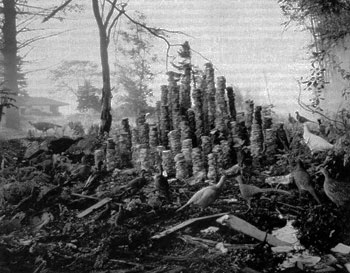Gregory Crewdson
Emily Tsingou, London
Art Monthly, Issue 224, March 1999

Image: Gregory Crewdson, Untitled
The living room is dark. Hardly unexpected at twilight, yet the decor suggests light is a rarity here; heavy, leafy wallpaper stifles the space. Old-fashioned brown furniture thickens the experience. The TV is wood-effect. If we could see the windows, they'd have net curtains. This is the home of an elderly couple, although they don't appear to be home. The first clue to their absence is the colossal nest of branches that fills the room. The second clue is the bear.
It seems that the American Narnia is too big to fit into a wardrobe, and so has taken over a living room. It is an odd sight, yet somehow natural. Perhaps this is the logical conclusion of such home decoration: the wallpaper goes rather well with huge lumps of tree, the chairs were never that far from their raw material in the first place, and it seems perfectly reasonable for a branch to protrude from the TV's ashen screen. William Morris might have balked at such extremes, but that's America for you: the land of all or nothing. What is strange though is the fact that the bear seems to have found something even more peculiar: among the various household products that litter the morass of foliage, a carton of milk has tipped and spilled. A perfectly circular puddle of pure white sits in the centre of the nest. A tasty treat for sure, but he stands transfixed, mesmerised to a degree more than the mere milk and taxidermy warrant. The bear is right; the living room may have gone to seed, but this business with the milk is really weird.
Back in the early 90s Gregory Crewdson was making miniature landscape dioramas and photographing them. This was before everyone else was. The hyperreal claustrophobia of these images gave way to a new set of small-scale black-and-white prints taken outdoors from a high vantage point. The locales were very similar; Crewdson had found a patch of suburban America that matched his model houses, archetypal as Arlen County. Following on from these works is this new series: 'Twilight'. The same town is used, but the images are large-scale (50" x 60") and in colour. Drifting in and outdoors, the artificial studio feel of the early work is projected out onto the 'real' world, the iconographic houses now squatting in a vast continent of forests, driveways, and blue TV light.
Filmic references abound, particularly in the theatrical lighting. Add to this the preoccupation with narrative, especially the outlandish circumstances Crewdson's characters find themselves in, and the associations become clear - which explains the curious sense that we've seen it all before: a woman hovers above overturned trashcans; a drunken teenager is transfixed by a shaft of light from the sky; a dead cow lies in a garden; a woman plants hundreds of flowers in her living room; a boy communicates with his sister through a circle on her stomach; towers of white sliced bread pile up in the woods attracting a fairy-tale assortment of birds. Odd events indeed, but American culture has thrived on such minor mysteries of late, from Spielberg and Lynch to the X-Files, and even cartoons - perhaps Kenny lies dead under the cow. The bastards.
A large-format camera was used, and this depth of detail is important. These are not doll's houses; this is the town of Lee. These are Lee's inhabitants, these are their houses. This is Lee's Fire Department, Police Department, Voluntary Search Team. But is this a 'real' fiction, or a dream sequence? Are we supposed to be deciphering symbols, analysing meanings? This is a fixation for Crewdson, and his characters search endlessly for meaning in the landscape. There is a palpable sense of belief to be seen in the faces of the town's inhabitants, whether they believe there must be a reason why a dead cow has appeared, or whether they believe that planting shed-loads of flowers in their living room was the right thing to do, it is the belief in meaning that these images are ultimately about.
Of course if you actively look for meaning you will find it everywhere. We are very good at believing. The religious, particularly, have always found meaning in nature. It is only during this century that the natural world has been seen as an accident: the product of physics and evolution. Understanding the creator's mind through the study of nature has long been discredited because there is no meaning, only mechanics. Yet nature is becoming suffused with conscious design: as biotechnology advances, so nature becomes strange to itself, and terrifyingly meaningful to us. The blind logic of Darwinism is no longer the determining factor.
There is now a diffuse sense of foreboding - and this is what manifests itself in Crewdson's photographs: a fear that there is actually meaning out there after all, just when we had accepted that there was none. It is not the fear of aliens or the supernatural, it's not even the fear of nature. It is the fear of ourselves, of mankind's influence as it splices itself between self-replicating molecules.
There is a deep ambivalence towards nature in Crewdson's expansive images, and this is one of the ways in which they bring to mind Don DeLillo's novel White Noise. In particular the passage where Babette claims that every technological advance is worse than the one before because it makes her more scared. Jack asks her what exactly it is that she's scared of. She replies 'The sky, the earth, I don't know'.
— End —